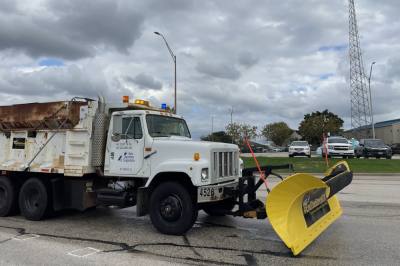The TxDOT Austin district has dozens of vehicles that will pre-treat roads ahead of storms, place granular material on icy roads and plow snow, according to Tucker Ferguson, TXDOT’s Austin district engineer. Ferguson detailed the district’s plans at a news conference Nov. 10.
Ferguson said his team has learned from Winter Storm Uri and Winter Storm Landon, which occurred in 2021 and 2022, respectively. He emphasized that the Austin district will adapt to weather patterns, changing road conditions and the length of storms.
“[During] any winter weather emergency, we are prepared to make sure major roadways are passable for those who need them most—specifically and especially for emergency responders,” Ferguson said. “This doesn't mean that they will be instantly free of snow and ice at any one time, but they should be passable for anyone who needs to use them.”
Tony Hartzel, a spokesperson for the TxDOT Dallas district, told Community Impact that crews in North Texas now add antifreeze components to their fuel to protect the fuel from freezing during severe weather.
“We don’t really really get [extreme temperatures] here, but when we do get them, it can be a challenge to keep that equipment running,” Hartzel said. “Those are the types of things that we learned [after Winter Storm Uri].”
Hartzel said Texans should stay at home during winter weather, if possible. If you cannot stay home, Hartzel said it is important to drive slowly and carefully in order to allow yourself to react to hazards.
Drivers should also give TxDOT crews plenty of room to work, Hartzel said—“don’t crowd the plow.”
“People think that it's safer to follow right behind our trucks; however, when we spray the brine and put the salt down, it doesn’t take effect immediately,” Hartzel said. “[It has] to work into the conditions that are there on the roadway, so following right behind us is not advisable. There still could be incidents or crashes based on following too closely.”
The TxDOT Houston district prepares for winter storms similarly to hurricane season: by preparing in advance instead of waiting for severe weather to occur, according to Danny Perez, a spokesperson for the district.
“We make sure all the offices [in the district] coordinate, that way when a storm is coming, we’re on constant call, and we make sure our emergency plan and winter weather plan are ready to go,” Perez told Community Impact.
At the news conference, Ferguson emphasized the importance of driving safely and preventing fatal crashes. Nov. 7 marked 22 years of daily deaths on Texas roadways, which TxDOT officials said are often due to distracted driving, speeding and not wearing a seatbelt.
“If you have become stranded in bad weather or are experiencing car trouble, do whatever you can to move away from traffic,” Ferguson said. “Secondary crashes are one of the leading causes of fatalities in the Austin district, and it can be especially dangerous when roadways are slick.”
A secondary crash occurs when one or more vehicles collide with a car that was already in an accident. According to the Federal Highway Administration, one in five car crashes are secondary crashes.
During winter weather, drivers can visit DriveTexas.org for real-time road conditions.







